
Journal of Mining and Earth Sciences, Vol 66, Issue 2 (2025) 15 - 28 15
Prediction of flyrock distance in open-pit mines using
an optimized artificial neural network with evolution
strategies
Hoang Nguyen 1, 2, *, Bao Dinh Tran 1, 2, Nam Xuan Bui 2, 3, An Dinh Nguyen 1, 2, Viet
Van Pham 1, 2, Hoa Thu Thi Le 1, 2, Thao Qui Le 1, 2, Hoan Ngoc Do 1, 2, Ngoc Tuan Le4,
Thanh Tuan Nguyen 1
1 Hanoi University of Mining and Geology, Hanoi, Vietnam
2 Innovations for Sustainable and Responsible Mining (ISRM) Research Group, Hanoi University of Mining
and Geology, Hanoi, Vietnam
3 Vietnam Mining Science and Technology Association, Hanoi, Vietnam
4 Vinacomin - Minerals Holding Corporation, Hanoi, Vietnam
ARTICLE INFO
ABSTRACT
Article history:
Received 14th Nov. 2024
Revised 18th Feb. 2025
Accepted 28th Feb. 2025
Blasting is a fundamental technique in open-pit mining, used to break rock and ore.
Its effectiveness and the degree of fragmentation significantly affect the efficiency of
subsequent processes and the overall mine productivity. However, a major concern
is the dangerous impact of flyrock, which poses serious safety risks to personnel and
equipment in the vicinity, potentially leading to fatal accidents. This paper presents
an advanced machine learning model, named ES-ANN, which combines an Artificial
Neural Network (ANN) with Evolution Strategies (ES) to predict flyrock distance in
open-pit mines with high accuracy. The ANN model is used to forecast flyrock
distances, while the ES technique optimizes the model's weights, enhancing
prediction accuracy. To evaluate the improvement of the proposed ES-ANN model,
another optimization model based on the Evolutionary Programming (EP)
optimization algorithm and ANN (abbreviated as EP-ANN), and a standalone ANN
model were developed and compared based on the same datasets. Blasting data
from the Ta Phoi copper mine (Lao Cai) was utilized for model training and
validation. The results indicated that the ES-ANN model achieved the highest
performance with an MAE of 2.095, RMSE of 2.711, and R2 of 0.952 on the testing
dataset (95.2% accuracy) in predicting flyrock distance. Meanwhile, the EP-ANN
and standalone ANN models only provided MAE of 5.512 and 7.300, RMSE of 6.692
and 8.938, and R2 of 0.708 and 0.479, respectively. Compared to the EP and
traditional methods, the ES-ANN model offered superior accuracy and reliability,
making it an effective tool for forecasting and managing flyrock hazards in open-pit
mining, thus enhancing operational safety.
Copyright © 2025 Hanoi University of Mining and Geology. All rights reserved.
Keywords:
Blasting,
Flyrock,
Machine learning,
Safety in mining,
Sustainable development.
_____________________
*Corresponding author
E - mail: nguyenhoang@humg.edu.vn
DOI: 10.46326/JMES.2025.66(2).03

16 Hoang Nguyen et al./Journal of Mining and Earth Sciences 66 (2), 15 - 28
1. Introduction
Open-pit mines commonly use the
synchronized drill-and-blast method to break
rock and ore, which is essential for subsequent
processes such as excavation, transportation,
waste disposal, and crushing. This method is
necessary due to the high hardness of the rock and
ore typically found in open-pit mines. While the
effectiveness of blasting for rock fragmentation in
open-pit mines is undeniable, it also has
significant environmental impacts. These include
blast-induced vibrations, air shock waves, flyrock,
ground shocks, and air pollution from dust and
toxic gases (Bach et al., 2015; Thang et al., 2015).
Among these, flyrock is particularly dangerous,
posing serious risks to the safety of nearby
personnel and equipment, with the potential to
cause fatalities.
In recent years, several mining operations
have failed to control flyrock during blasting,
leading to "rock showers" that have fallen on the
homes and properties of local residents. This has
endangered the safety of those living in the area
and caused damage to buildings, farmland, and
other structures (Dong, 2024; Luat, 2024; Nien,
2024; Phong, 2024; Plus, 2024) (Figure 1).
In practice, the Vietnam Ministry of Industry
and Trade's regulation QCVN 01:2019/BCT
(Trade, 2019) sets the safe flyrock distance at 300
meters for people and 200 meters for equipment
during blasting with large-diameter drill holes.
For mines with significant elevation differences,
the required safe distance increases by 1.5 times.
However, in many cases, blasting operations have
resulted in flyrock distances far exceeding these
safety limits, making it impossible to control or
predict the flyrock range, as previously
mentioned.
To address this issue, some researchers have
proposed empirical formulas to predict flyrock
distance caused by blasting, but their accuracy
remains limited (Ghasemi et al., 2012; Jahed
Armaghani et al., 2016).
With the advancement of science and
technology in the era of Industry 4.0, researchers
globally have shifted toward more sophisticated
models utilizing machine learning and artificial
intelligence. These models aim to better
understand the relationship between flyrock and
blasting parameters, as well as the physical and
Figure 1. Evidence of Flyrock Incidents from Blasting at Open-Pit Quarries (Vietnam) (Law, 2024;
Plus, 2024).

Hoang Nguyen et al./Journal of Mining and Earth Sciences 66 (2), 15 - 28 17
mechanical properties of the rock, in order to
improve prediction accuracy. Several machine
learning models have been developed worldwide
to predict flyrock distance. One such model is the
Outlier Robust Extreme Learning Machine
(ORELM), which was designed to reduce the
impact of outliers, thereby providing more stable
and accurate predictions (Lu et al., 2020).
Additionally, Zhang et al. (2024) developed a
Stacked Multiple Kernel Support Vector Machine
to predict flyrock distances at the Sugun copper
mine in Iran, achieving an accuracy of
approximately 99%. Another model worth noting
is the Monte Carlo-based regression model,
developed by Armaghani et al. (2016), which was
used to predict flyrock distance from blasting at
the Ulu Tiram quarry in Malaysia, showing an
accuracy of 85.5%. Li et al. (2023) also developed
a hybrid model combining Harris Hawks
Optimization and Multi-strategies-based Support
Vector Regression to predict flyrock distances in
open-pit mines, with an accuracy of 96.6%.
While these studies demonstrate the high
reliability of modern machine learning models in
predicting flyrock distances, researchers have
also cautioned that the accuracy of these models
needs to be carefully reviewed or further tested
when applied to different regions. Variations in
data characteristics (such as geological
conditions, geophysical properties, and rock
mechanics) mean that results from one area
cannot be generalized to others. As such, these
models cannot be directly applied in Vietnam
without careful research and adaptation.
Therefore, in this study, the authors developed a
new machine learning model based on Evolution
Strategies Optimization and an Artificial Neural
Network (ANN), abbreviated as ES-ANN, and
tested its feasibility with appropriate parameters
at the Ta Phoi copper mine in Lao Cai, Vietnam.
Another optimization model based on the
Evolutionary Programming (EP) optimization
algorithm and ANN, namely EP-ANN, and a
standalone ANN model are also developed to
compare with the proposed ES-ANN model in
predicting blast-induced flyrock based on the
same datasets. The research methodology and
results are discussed in the following sections of
this paper.
2. Methodology
2.1. Multi-layer perceptron neural network
The MLP (Multi-Layer Perceptron) neural
network is a type of neural network with a multi-
layer structure. It consists of at least three main
layers: the input layer, the hidden layer (which
can have multiple hidden layers), and the output
layer. MLP is one of the most commonly used
neural network types and is widely applied to
classification and regression tasks (Khashei et al.,
2012; Desai & Shah, 2021; Uncuoglu et al., 2022;
Xu et al., 2022; Zhang et al., 2023). In this study,
we use an MLP neural network to predict flyrock
distance caused by blasting in open-pit mines,
which is a regression problem.
The input layer of the MLP neural network is
responsible for receiving the initial data and
passing this information into the network. The
number of neurons in the input layer corresponds
to the number of features (input variables) in the
data.
In the hidden layer, the neurons apply
nonlinear transformations (typically using
activation functions such as ReLU, Sigmoid, or
Tanh) to learn complex patterns within the data,
discovering relationships and rules.
Finally, the MLP provides the final prediction
at the output layer, where the number of neurons
corresponds to the predicted flyrock distance
caused by blasting in open-pit mines. Figure 2
illustrates the structure of the MLP model used to
predict flyrock distance from blasting in open-pit
mines.
The operating principle of an MLP neural
network is as follows: the MLP learns to transform
data by updating its weights through the process
of backpropagation. This algorithm involves both
forward and backward propagation (Naskath et
al., 2023).
- Forward propagation: Data is passed
through each layer of the network, from the input
layer to the output layer. At each layer, the input is
multiplied by the weights, a bias is added, and the
result is passed through an activation function to
produce the layer's output.
- Backward propagation: After the network
makes a prediction, a loss function is used to
calculate the error between the predicted values
and the actual values. This error is then

18 Hoang Nguyen et al./Journal of Mining and Earth Sciences 66 (2), 15 - 28
propagated backward through the network to
update the weights using optimization algorithms
such as gradient descent. This process allows the
network to self-correct and improve accuracy by
minimizing the error.
2.2. Optimization algorithms based on
evolutionary techniques
2.2.1. Evolutionary programming (EP)
Evolutionary Programming (EP) is an
optimization method based on the principles of
natural evolution and is part of the broader family
of Evolutionary Algorithms (EAs). It was
developed by Fogel (1962) in the 1960s with the
original aim of simulating biological evolution to
solve complex problems (Fogel, 1964).
The key features of the Evolutionary
Programming algorithm include:
1. Simulating the evolutionary process: EP
simulates evolution by generating and evolving a
population of potential solutions (individuals) to
a given problem. These individuals are
represented as numerical strings or other suitable
data structures for solving the problem.
2. No crossover operation: Unlike Genetic
Algorithms (GA), EP does not use crossover
between individuals. Instead, it focuses on
mutation to introduce diversity within the
population.
3. Evaluation and selection: Each individual in
the population is evaluated based on a fitness
function, which reflects how well that solution
meets the problem's objectives. The better-
performing individuals have a higher chance of
surviving and reproducing in the next generation.
4. Unconstrained optimization: EP is well-
suited for unconstrained optimization problems
and can be easily applied to complex or
discontinuous objective functions.
The basic steps of the Evolutionary
Programming algorithm are as follows:
- Step 1: Initialization: Generate a random
population of individuals representing potential
solutions to the problem.
- Step 2: Mutation: Apply mutations to the
individuals to create new solutions.
- Step 3: Evaluation: Measure the fitness of
each individual based on the objective function.
- Step 4: Selection: Choose the best
individuals to proceed to the next generation.
EP emphasizes exploration of the search
space through mutation and is particularly
Figure 2. MLP model structure for predicting flyrock distance from blasting in open-pit mines.

Hoang Nguyen et al./Journal of Mining and Earth Sciences 66 (2), 15 - 28 19
effective for problems with large or complex
solution spaces.
2.2.2. Evolutionary strategies (ES)
Evolution Strategies (ES) is an optimization
method based on the principles of natural
evolution, similar to other evolutionary
algorithms (EA) such as Genetic Algorithm (GA)
and Evolutionary Programming (EP). ES was
developed by Rudolph (2000) to address
optimization problems by simulating biological
processes.
The key features of Evolution Strategies (ES)
include individual representation, mutation,
recombination, selection, and self-adaptation of
strategy parameters (Hansen et al., 2015). In ES,
individuals are typically represented as real-
valued vectors, where each value (gene)
corresponds to a parameter to be optimized. Each
individual consists of two components:
- Genotype: The solution values.
- Strategy parameters: Parameters such as
the standard deviation (σ) used during mutation.
Mutation is the primary mechanism in ES.
Unlike GA, which focuses on recombination, ES
emphasizes small changes in individuals through
random mutation (Back, 1996). Mutation usually
involves adding a randomly generated value from
a normal distribution to both the solution
parameters (genotype) and the strategy
parameter (σ). This allows ES to self-adapt the
degree of change throughout the evolutionary
process.
ES can also use recombination, but it is not
the main factor as it is in GA. Recombination may
occur between individuals to create a new
individual by combining solution parameters
(genotypes) from two or more parents (Beyer &
Arnold, 2001).
Selection in ES is similar to that in GA, but it
uses two main types:
- (μ + λ) selection: In this strategy, both the
current generation (μ individuals) and the
offspring (λ individuals) compete for a place in the
next generation. This helps retain some of the
better traits from the previous generation.
- (μ, λ) selection: In this strategy, only the λ
offspring are evaluated, and the current
generation is completely replaced. This is a more
aggressive evolutionary strategy, enabling
broader exploration of the search space.
In the next step, ES self-adjusts its strategy
parameters, such as the mutation standard
deviation (σ), which is a defining feature of ES.
This enables the algorithm to adapt to the search
space and gradually improve optimization as it
progresses through generations.
The structure of the Evolution Strategies
algorithm involves five basic steps:
1. Initialization: ES generates an initial
random population of μ individuals, each with
solution parameters and strategy parameters.
2. Mutation: ES mutates the individuals by
adding a random value from a normal distribution
to the parameters.
3. Recombination (optional): ES performs
recombination between individuals to create new
individuals.
4. Evaluation: ES calculates the objective
function for the newly created individuals.
5. Selection: ES selects the best individuals
from both the current and new generations to
advance to the next generation (in the μ + λ or μ, λ
strategy).
ES is commonly used for continuous
optimization problems where the parameters to
be optimized are represented as real numbers,
such as the problem of predicting flyrock distance
in blasting operations, which is addressed in this
study. ES combines flexible exploration of the
search space (through mutation and self-
adaptation) with the ability to exploit the best
individuals (through selection). This makes it a
powerful tool for optimizing complex problems
and is widely used in various engineering and
scientific fields.
2.3. Optimizing ANN using optimization
algorithms based on Evolutionary Strategies
(EP-ANN and ES-ANN)
This paper employs the Multi-Layer
Perceptron (MLP) artificial neural network as the
primary model for predicting flyrock distance
caused by blasting in open-pit mines. The
essential components of the MLP model include
input parameters, the network structure, and
output parameters (flyrock distance).
In an MLP network, neurons are organized
into multiple layers and interconnected by


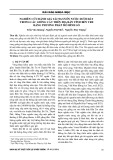
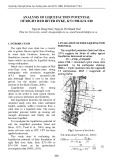

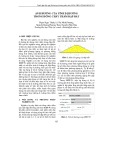
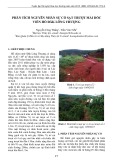
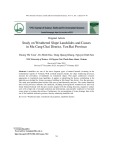
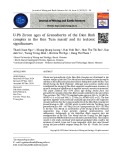
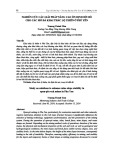
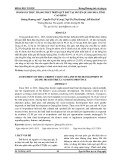

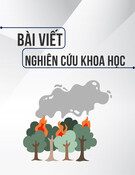

![Quy hoạch tổng thể Cà Mau: Tài liệu [mới nhất/chuẩn nhất]](https://cdn.tailieu.vn/images/document/thumbnail/2025/20250827/tghong1621@gmail.com/135x160/49401756278390.jpg)


![Bài giảng Hàng hải địa văn [chuẩn nhất]](https://cdn.tailieu.vn/images/document/thumbnail/2025/20250729/vijiraiya/135x160/43361753782101.jpg)
![Bài giảng Trắc địa cơ sở [mới nhất]](https://cdn.tailieu.vn/images/document/thumbnail/2025/20250729/vijiraiya/135x160/84_bai-giang-trac-dia-co-so.jpg)





![Atlas tài nguyên nước Việt Nam: Tài liệu [Mô tả/Hướng dẫn/Chi tiết]](https://cdn.tailieu.vn/images/document/thumbnail/2025/20250715/vijiraiya/135x160/348_tai-lieu-atlas-tai-nguyen-nuoc-viet-nam.jpg)
![Hệ thống câu hỏi ôn tập Vùng kinh tế [chuẩn nhất]](https://cdn.tailieu.vn/images/document/thumbnail/2025/20250709/kimphuong1001/135x160/76921752140578.jpg)
